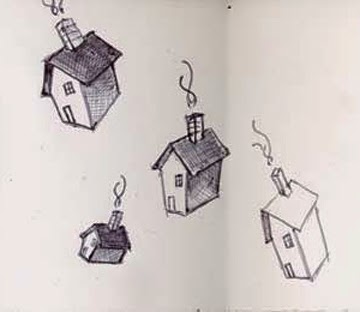I’ve been hard at work. My son was born a week ago yesterday and after 5 days of sitting still, growing used to the idea of being a father, coupled with helping my wife out and about, I started to get very antsy. I determined that I needed to create grids that were environments of their own. I wanted to control the space, both from the point of how a viewer would be able to access that space and where that work could be positioned.
A little over a year ago, I adopted an image of falling houses as an indication of nuclear families surrounding me but never feeling terribly apart of me. I’m now one child away from a nuclear family but that house image still sits with me. There is something very profound to me about the symbol that indicates stability, family, good health, American Values, and prosperity. I don’t think any symbol of the American Dream is more accessible than the simple house. Our children understand it and draw it from a very young age. It is not so much the object which makes it important, but everything that it represents to the child. That is where his or her family lives. There they are, or at any rate should be, completely safe. It is a symbol of the thing that they have come to understand from living in a space with the same people for a number of years, people that most likely have been with you since day one.
Ideas of family still appear far different in this 21st Century than they did in previous centuries. Our families are not as close as they used to be. College age people move all over the country, sometimes never to come back. We are a trans-familial society if we are to use Baudrillard’s logic. When Baudrillard uses the prefix “trans,” he refers to an item in culture which is experienced by the simulacra, or copies that depict things that either had no reality to begin with, or that no longer have an original. In essence, our idea of family is what we see on television and in the movies. This cookie cutter existence which is prescribed by various clothing, household goods, and technology companies is indicative of a happiness that never existed in that way to begin with. It’s similar to that saying “money can’t buy you happiness.”
During my wife’s pregnancy and our ensuing birth, I began to lose myself in reading on cultures which stressed oral histories passed along through the bloodlines. The indigenous tribes of the Pacific Northwest particularly held my attention. The art work and mythologies which are so unique and specific to each tribe seemed a healthy alternative to the cultural sameness which modern America seems to prefer. The design and pattern in the work seemed to speak of an order and a logic by which the people lived. Naturally, as my social life changed, I sought out this same type of order through patterns of my own. I also started to reincorporate characters into my work, defining them through mythologies that I steadily made up. The final straw which cast me into this present work occurred while reading about Chief Joseph and the Nez Perce. Christian missionaries worked with the Nez Perce, who were a very receptive nation, to instill in them the ideas of Christianity. After a time of adopting the Christian Religion, many Nez Perce returned to their owner dreamer faith. The Nez Perce believed in spirits called weyekins which would, they thought, offer “a link to the invisible world of spiritual power”(1).
This idea of spirits linked to spiritual power reminded me of David Lynch’s Twin Peaks. I started to think about the White Lodge and the Black Lodge. My brain leaped to the falling houses again; symbols of a lodge, a home where people congregated, a spiritual dwelling. It suddenly made sense to create a lodge of my own. It is the Lewis’s White Lodge, where the Mighty Lark is omniscient. It is a place of safety for my boy.
The idea is still taking a little shape, but at least I understand how there is a context to mix these creatures and my more contemporary painting work. There is a spirituality and a mythology brewing which I think will explain for me some of my dependency on this more illustrative method of communication.
Peace
-Mike
(1) Hoxie, Frederick E.; Nelson, Jay T. (2007). Lewis & Clark and the Indian Country: the Native American Perspective. Urbana, Illinois: University of Illinois Press. pp. 66–67. ISBN 0252074858. OCLC 132681406


